Knit Christmas Decorations, Easter Decorations, Baby’s Nursery Decorations and Lots of Different Birds Using These Lively Bird Knitting Patterns
Would you be interested in using your leftover yarn scraps to knit adorable stuffed birds — birds that you could give to children as toys, use for making a baby’s mobile, use for Christmas tree decorations or decorate with all year long? And would you also be interested in learning how to make fun accessories for your birds such as glasses, scarves and hats? How about making cute and useful tea cozies or pincushions to match your birds? If all this sounds like fun to you, Arne & Carlos Field Guide to Knitted Birds is a book you’re going to want to know about. I think you’ll find it absolutely delightful!
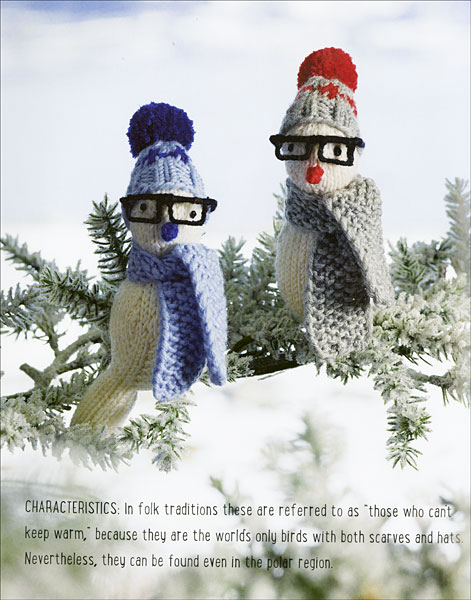

What You Need to Know About This Knitting Pattern Book:
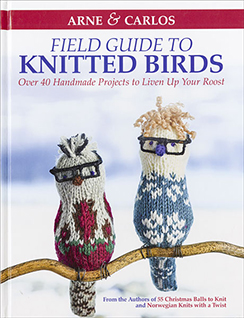
Authors: Arne Nerjordet & Carlos Zachrison (“Arne & Carlos”)
Publisher: Trafalgar Square Books
Copyright Date: I’m reviewing the English language translation of the book, which has a copyright date of 2017. This book was translated from an earlier Norwegian version.
ISBN 13: 978-1570768231
ISBN 10: 1570768234
Book Format: Sturdy hardcover without dust jacket; includes full color photographs
Number of Pages: 176 pages
The Focus of This Book:
This book is all about knitting birds, birds and more birds. Some of the birds resemble real-life birds. Others are fun, imaginative, made-up birds that might make you laugh out loud, or at least chuckle a bit — like the silly bespectacled birds on the front cover of the book that are made to look like the book’s authors. There are several other knitting patterns included for making projects that enhance the birds, but the birds are clearly the main focus of this book.
Knitting Projects Included in The Field Guide to Knitted Birds:
There are bunches of different realistic and fanciful birds you can make using the patterns included in this book. The birds can be grouped into major categories as follows:
- Winter birds
- Embroidered birds
- Garden birds
- Birds in traditional sweaters
- Spring birds
- Rare birds of paradise

The Best Things About This Book
This book is so pretty that you really don’t need to be a knitter to enjoy it. Case in point: Shortly after I got my copy of the book, my toddler hijacked it and wouldn’t let me read it without her. She adores it! She is absolutely delighted by the colorful photos of the knitted birds pictured in various settings: some perched in flower pots, others adorning a lively Christmas tree.
This book is witty, funny and amusing. The humor doesn’t stop with the fun title and cover. It’s subtly incorporated throughout the book’s pages. I think you will find it quite appealing.
For example, one of the fancier “rare birds of paradise” is called “The White I Do I Do I Do”. The photographer has taken a lovely picture of this knitted bird perched on top of a formal bouquet of roses. The “field guide” description for the bird is as follows:
“Characteristics: Can be confused with a bird of paradise because of the long fluttery tail. The back and wings are shiny pink. Pink eyes and burgundy beak. Often flies up into wedding cakes and has a tendency to nest close to party venues.”
Tee hee hee hee hee!
Even if you don’t actually knit any of the birds presented in this book, you’re likely to get bunches and bunches of giggles from reading its pages.
The colorful styling and photography must have taken many hours to conceptualize, initiate and complete. The project photos in this book go well beyond the usual bland presentation that’s common in other knitting pattern books. You do get to see some of these knitted birds presented on plain white backgrounds, which will enable you to easily comprehend the details on each bird; but you also get much more than that. You’ll see the birds presented in imaginative settings — in glorious vintage bird cages; outside lovely real bird feeders; under interesting glass domes; and perched atop twigs or branches or flower pots or Christmas wreaths. It’s evident when looking at this book that a LOT of creativity and brainpower went into making it. I’d be really surprised if you don’t find this book inspiring for that reason alone.
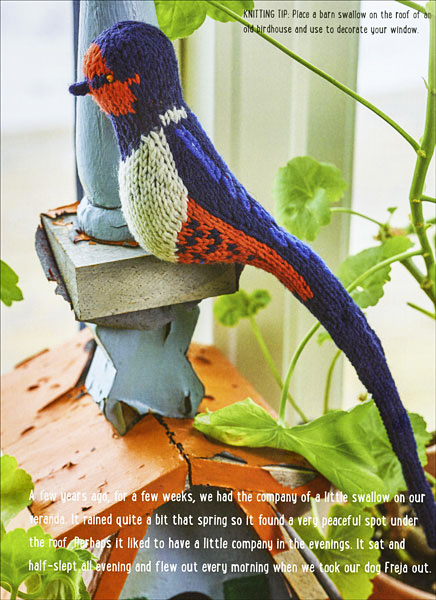
Decorating with twigs, tree branches and other natural elements has been a top home decor trend lately. If you’re onboard with this trend, it could be a whole lot of fun to incorporate birds from this book into your nature-inspired home décor.
Step-by-step photography helps you with understanding the intricate details on these projects. There are step-by-step photo sequences for making the birds’ beaks, eyes and supports; for sewing on sequins and attaching feathers on the “birds of paradise”; and for embroidering duplicate stitch details on the birds. There’s also a step-by-step photo sequence for creating a vignette with knitted birds and real twigs to place under a glass bell.
Unless you’re already an expert knitter, this book is likely to teach you some helpful knitting techniques. By the time you’ve knitted a few of the birds in this book, you’ll be comfortable knitting short rows and using double-pointed knitting needles, both of which are really helpful skills to know. You don’t need to know stranded colorwork knitting to start out with, because there are bird patterns included in the book that only require you to work with one color at a time. However, this book does give you the opportunity to learn and perfect your stranded color knitting skills, too. (If you need help with stranded colorwork knitting, you’ll also want to check out the Alterknit Stitch Dictionary, which is an outstanding reference on how to do that technique.)
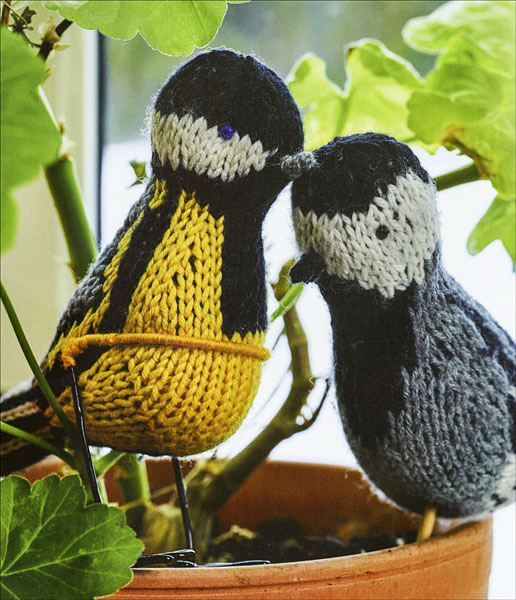
Things to Be Aware of Before You Buy This Book
This book has actually prompted me to re-evaluate my standards for what constitutes an outstanding value in a craft pattern book.
Technically, all 40+ of these birds are variations of one basic knitting pattern. You might think that there would be bunches of different bird patterns — perhaps a gigantic knitted eagle or flamingo or emu or raven or osprey, along with a different, much smaller pattern for, say, a hummingbird — but no. The birds included in this “field guide” are all based on one, single bird knitting pattern. You won’t find any flamingos, ospreys or emus here; the focus is on birds that can all be knitted from the same basic pattern as a robin, bullfinch or barn swallow. The details that differentiate each bird come from the color patterning, embroidery or applied details such as tail feathers.
The upside to this is that it becomes reasonably easy to get comfortable with the pattern.
Another plus: The team at Trafalgar Square Books has chosen to present the basic pattern in several easy-to-access places including a fold-out page in the back of the book and a separate handout that is included. The extra handout makes it super easy to find and use the basic pattern, instead of having to flip pages back and forth when you work from one of the many charts to customize a particular bird. They’ve put together an extremely user-friendly package for you.
But the downside is that if you do not happen to like that one basic pattern, the book is going to be disappointing for you. So study the birds pictured on this page closely — because if you like them, you’re probably going to LOVE this book — and if you don’t like them, you’re probably not going to like the book at all, because it basically contains more of the same.
However, the book does also include instructions for knitting a few other items such as tiny bird hats and scarves, a couple of variations of a tea cozy, and a pincushion.
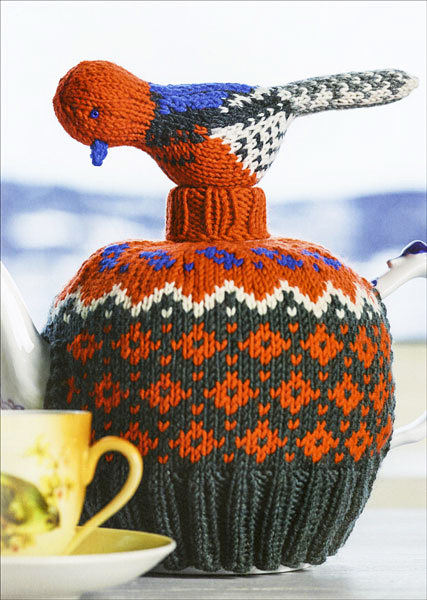
The Field Guide to Knitted Birds vs. Arne & Carlos Favorite Designs
As I mentioned above, this book has prompted me to completely re-evaluate my standards for what constitutes a great value in a craft book. Before, I was overly concerned with how many patterns you were getting for the money spent on a book. With this book, if you look at it in those terms, you may be disappointed — because really, despite there being 40+ different variations of the basic bird, there is only really one bird pattern to work with. The addition of a bird hat pattern, bird scarf pattern, tea cozy pattern and pincushion pattern do bump the total pattern count up a little bit.
This is one of those books where the inherent value comes more from the joy you’ll derive by looking through its pages than it does from the pattern count.
If you want to try knitting birds in a broad variety of different color schemes, and you enjoy the thorough exploration of a theme, you will probably find this book to be a good value for the money you’ll spend on it. Likewise, if you have a sizable stash of yarn scraps, and you aren’t sure what to make with them, this book is a fantastic candidate for finding projects that will allow you to use up all those scraps. If there are numerous children on your gift list, this book will probably be an excellent investment for you. It will also prove to be a wise investment if you have a bare Christmas tree, and you want to knit bunches of colorful bird-shaped ornaments to decorate it with.
If, on the other hand, you are convinced, as I was, that a high pattern count in proportion to the page count is necessary to derive a good value from a knitting book, please take a look at a similar title by the same authors: Arne & Carlos Favorite Designs.
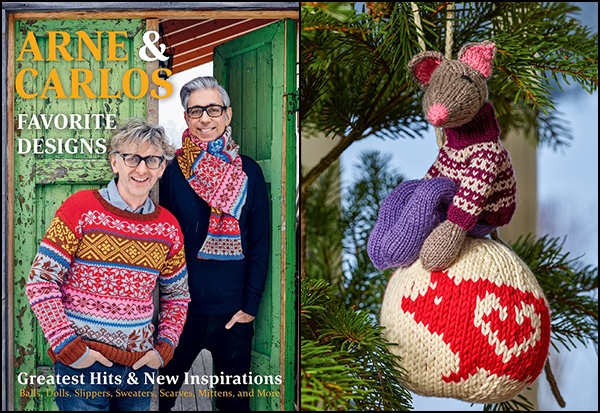
Arne & Carlos Favorite Designs is sort of a retrospective of Arne & Carlos’ career as craft pattern designers. It contains their best-selling and favorite craft patterns gathered from their other books, plus 15 new patterns that aren’t yet found anywhere else.
One major highlight of Arne & Carlos Favorite Designs: It includes the basic pattern for the knitted bird from The Field Guide to Knitted Birds, along with a HUGE BUNCH of other exciting patterns — knitted doll patterns, multiple slipper patterns, patterns for Christmas ornaments, a knitted teddy bear pattern, men’s and women’s sweater patterns, gorgeous crochet blanket patterns, lovely embroidery patterns and much more. So if you think you might want to try knitting a bird or two, but you don’t think you need an entire book’s worth of bird variations, I think you are really going to want to get your hands on a copy of Arne & Carlos Favorite Designs.
In my opinion, the “joy value” of Arne & Carlos Favorite Designs is just as great as the joy value for The Field Guide to Knitted Birds; both books feature the same type of imaginative styling — but Arne & Carlos Favorite Designs gives you a much broader variety of patterns to work with.
Errata for The Field Guide to Knitted Birds by Arne and Carlos
There are a few minor mistakes in The Field Guide to Knitted Birds. The publisher has made corrections available. See this page for errata.
Conclusion
I’m delighted to recommend The Field Guide to Knitted Birdsto other knitting enthusiasts, particularly to knitters who are enthusiastic about the idea of knitting bunches of birds in different color schemes using a single, basic bird pattern. I think this book will be an excellent investment for knitters who enjoy knitting small Christmas gifts or knitting for children; it’s also an ideal investment for knitters who have sizable amounts of scrap yarn on hand or sizable stashes of sequins, feathers and embroidery floss. This book will definitely give you excellent ideas for how to use up those sequins, feathers and scraps of yarn or embroidery floss you might have stashed!
For knitters who would only be interested in knitting a bird or two, I recommend Arne & Carlos Favorite Designs as a fantastic alternative to consider. It doesn’t cover knitted birds as thoroughly or as in-depth as The Field Guide to Knitted Birds does, but it offers many other wonderful types of patterns in addition to a knitted bird pattern.
Both are outstanding, inspiring books; if your pattern budget is big enough to allow you to buy both books, I would say buy them both!
Where to Buy The Field Guide to Knitted Birds:
Similar Knitting and Crochet Books and Related Resources
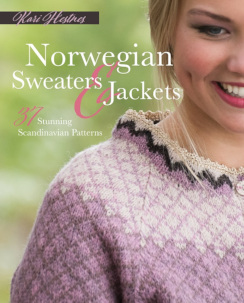
We invite you to check out our main directory of picks for the best knitting books ever. This book is included on the list.
One of this book’s main selling points is that the projects in the book are all totally gift worthy. If you’re looking for similar crochet or knitting books that feature gift worthy patterns, check out the following titles:
- Knitting for the Fun of It! — This book is remarkable because it contains a broad variety of patterns that are colorful, yet relatively easy to knit. Every project in the book is gift worthy. Many of the projects are smaller, like wrist warmers. There are also a few more impressive gift ideas, like crocheted blankets and knitted ponchos.
- Fair Isle Knitting — This is another book featuring a whole bunch of different ideas for gift-worthy projects made using the stranded colorwork / Fair Isle knitting technique.
- Jorid Linvik’s Big Book of Knitted Socks — Handknitted socks make amazing gifts, and these patterns will give you completely unique versions that are sure to delight your gift recipients.
- Jorid Linvik’s Big Book of Knitted Mittens — These mittens all feature interesting designs with loads of personality. There are patterns for giraffe mittens, cat mittens, mittens for rock ‘n’ roll fans, mittens for sailors, and mittens for just about anyone else you might like to make knitted gifts for. Another really cool thing about this book: Some (but not all) of the mittens coordinate beautifully with the socks from Jorid’s Big Book of Knitted Socks. So if you grab both books, you can knit coordinated sets for yourself and your loved ones.

Learn More About Knitting

- Click here to check out our beginner’s guide to knitting needles.
- Click here to find our picks for the best knitting books of 2023 and beyond.
- Find the Most Important Knitting Abbreviations You Need to Know
- Discover the Best Yarn for Knitting and Crocheting
Posted By: Amy Solovay
This page was last updated on 7-30-2023.